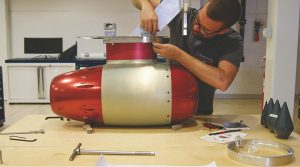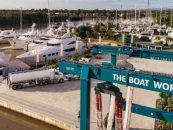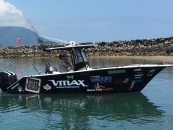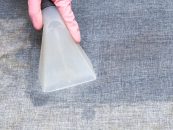The boat world’s advanced rim-drive electric engine
Article by Andrew Bedggood
 A Milan-based startup called Sealence is set to revolutionise the boating world with its rim-drive electric engine, DeepSpeed. William Gobbo, founder and manager, began with the idea of creating a more efficient electric propulsion system which provided the speed and range of conventional petrol or diesel engines, but was far more eco-friendly. Teaming with Ernesto Benini, an expert in fluid dynamics from Padua University, they created the first nautical electric hydro jet propulsion system.
A Milan-based startup called Sealence is set to revolutionise the boating world with its rim-drive electric engine, DeepSpeed. William Gobbo, founder and manager, began with the idea of creating a more efficient electric propulsion system which provided the speed and range of conventional petrol or diesel engines, but was far more eco-friendly. Teaming with Ernesto Benini, an expert in fluid dynamics from Padua University, they created the first nautical electric hydro jet propulsion system.
University simulations demonstrated that combining the concepts of electric and jet engines resulted in a product significantly more efficient than conventional propeller systems, even at low speed. In fact, the difference in efficiency becomes greater as speed increases, with propeller performance decreasing due to cavitation and tip losses, while the electric hydro jet motor becomes progressively more efficient due to increased water flow.
Externally, a DeepSpeed engine is reminiscent of an aeroplane jet engine, with a sleek housing that is designed to funnel water from the front and accelerate it out through a small jet nozzle at the rear. Internally, the DeepSpeed technology uses impeller blades on a revolving outer ring driven by a permanent magnet synchronous motor. Since electric circuitry has replaced gears, shafts, and universal joints, there are none of the associated mechanical losses present when conventional systems transfer power from the engine to the drive.
DeepSpeed systems can work with any energy source: batteries, fuel cells, or even a hybrid arrangement.
 To optimise efficiency, DeepSpeed engines may be mounted under the hull, which eliminates the need to redirect waterflow, unlike traditional hydro jet engines, and it eliminates the need for a cooling system. The motors can be fitted as single or twin installations in either sterndrive or pod-style mounts.
To optimise efficiency, DeepSpeed engines may be mounted under the hull, which eliminates the need to redirect waterflow, unlike traditional hydro jet engines, and it eliminates the need for a cooling system. The motors can be fitted as single or twin installations in either sterndrive or pod-style mounts.
Other benefits of the much smaller, lighter, quieter, and smoother operating motors, compared to conventional petrol or diesel systems, include a further reduction in noise and vibration due to the motor being located outside the hull rather than inside it. Also, disturbance to marine habitats is minimised, with a significant reduction in water pollution and noise emissions.
Sealence is currently completing development of its range, focusing on larger, more powerful units, notably 420 hp (220 kW, 560 Nm torque) and 780 hp (500 kW, 1500 Nm torque) equivalent motors to be available later in 2021.
According to trials, a pair of 280e pods, when fitted to a 12 m, 12-tonne sportscruiser, should produce a top speed of 38 knots. The 420e has been designed for fast recreational hulls, while the 780e has been optimised to reach its maximum efficiency in the speed range from 16 to 26 knots on semi-planing hulls.
Recently Sealence was granted a patent in Australia, to add to its European patent, and increased its capitalization to € 13.5M. Its fundraising campaign runs until December 22, 2021 with proceeds going to complete development of the electric hydro jet motors and have full production, marketing, and sales in place for the beginning of 2022.
The company’s long-term goal is to offer a complete hybrid electric drivetrain package, suitable for a wide range of boats, that includes a modular system of expandable lithium-ion batteries, solar panels, and a diesel range-extender, all controlled by a single Smartbox.
Ultimately, Sealence wants to develop applications for commercial freight and passenger vessels.
Published in print July-September 2021


























